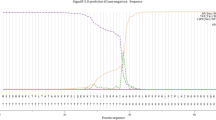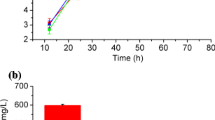Abstract
A gene encoding phzR was isolated from a phenazine-producing bacterium Pseudomonas aeruginosa 2016NX1. This paper provided the full-length cDNA encoding phzR (GenBank Accession no., MW143078). The cDNA of the phzR contained an open reading frame (ORF) of 714 bp. The potential regulatory elements were predicted in the phzR promoter region. The deduced amino acid sequence of P. aeruginosa phzR showed significant homology to the known phzRs from different organisms. Gene overexpression analysis showed that the phenazine content was improved (44.39%) in comparison to wild-type 2016NX1.



Similar content being viewed by others
References
Xiao M, Ruan C, Chen S, Liu Y, Lu Z (2018) Isolation and identification of a bacterium producing natural blue pigment. J Guangxi Normal Univ (Natural Science Edition) 36:131–138
Xiao M, Sun M, Ruan C, Chen S, Liu Y, Lu Z (2019) Inhibitory effect of biocontrol bacterium 2016NX1 on plant pathogenic fungi and optimization of fermentation conditions. J Guangxi Normal Univ (Natural Science Edition) 37:168–178
Liu TT, Ye FC, Pang CP, Yong TQ, Tang WD, Xiao J, Shang CH, Lu ZJ (2020) Isolation and identification of bioactive substance 1-hydroxyphenazine from Pseudomonas aeruginosa and its antimicrobial activity. Lett Appl Microbiol 71:303–310
Mavrodi DV, Peever TL, Mavrodi OV, Parejko JA, Raaijmakers JM, Lemanceau P, Mazurier S, Heide L, Blankenfeldt W, Weller DM, Thomashow LS (2010) Diversity and evolution of the phenazine biosynthesis pathway. Appl Environ Microbiol 76:866–879
Papavassiliou KA, Papavassiliou AG (2016) Transcription factor drug targets. J Cell Biochem 117:2693–2696
Yu JM, Wang D, Ries TR, Pierson LS III, Pierson EA (2018) An upstream sequence modulates phenazine production at the level of transcription and translation in the biological control strain Pseudomonas chlororaphis 30–84. PLoS ONE 13:e0193063
Chin-A-Woeng TF, Thomas-Oates JE, Lugtenberg BJ, Bloemberg GV (2001) Introduction of the phzH gene of Pseudomonas chlororaphis PCL1391 extends the range of biocontrol ability of phenazine-1-carboxylic acid-producing Pseudomonas spp. strains. Mol Plant-Microbe Interact 14:1006–1015
Khan SR, Herman J, Krank J, Serkova NJ, Churchill ME, Suga H, Farrand SK (2007) N-(3-hydroxyhexanoyl)-l-homoserine lactone is the biologically relevant quormone that regulates the phz operon of Pseudomonas chlororaphis strain 30–84. Appl Environ Microbiol 73:7443–7455
Khan SR, Mavrodi DV, Jog GJ, Suga H, Thomashow LS, Farrand SK (2005) Activation of the phz operon of Pseudomonas fluorescens 2–79 requires the LuxR homolog PhzR, N-(3-OH-Hexanoyl)-L-homoserine lactone produced by the LuxI homolog PhzI, and a cis-acting phz box. J Bacteriol 187:6517–6527
Pierson LS III, Keppenne VD, Wood DW (1994) Phenazine antibiotic biosynthesis in Pseudomonas aureofaciens 30–84 is regulated by PhzR in response to cell density. J Bacteriol 176:3966–3974
Wood DW, Pierson LS III (1996) The phzI gene of Pseudomonas aureofaciens 30–84 is responsible for the production of a diffusible signal required for phenazine antibiotic production. Gene 168:49–53
Green MR, Sambrook J (2012) ‘‘Molecular Cloning, a Laboratory Manual’’ 4th ed., Cold Spring Harbor Laboratory Press
Xu H, Dong X, Ai Q, Mai K, Xu W, Zhang Y, Zuo R (2014) Regulation of tissue LC-PUFA contents, Δ6 fatty acyl desaturase (FADS2) gene expression and the methylation of the putative FADS2 gene promoter by different dietary fatty acid profiles in Japanese seabass (Lateolabrax japonicus). PLoS ONE 9:e87726
Yang X, Wang D, Zhou Q, Nie F, Du H, Pang X, Fan Y, Bai T, Xu Y (2019) Antimicrobial susceptibility testing of Enterobacteriaceae: determination of disk content and Kirby-Bauer breakpoint for ceftazidime/avibactam. BMC Microbiol 19:240
Marchler-Bauer A, Bryant SH (2004) CD-Search: protein domain annotations on the fly. Nucleic Acids Res 32:327–331
Chenia HY, Jacobs A (2017) Antimicrobial resistance, heavy metal resistance and integron content in bacteria isolated from a South African tilapia aquaculture system. Dis Aquat Organ 126:199–209
Lin M, Wu X, Yan Q, Ma Y, Huang L, Qin Y, Xu X (2016) Incidence of antimicrobial-resistance genes and integrons in antibiotic-resistant bacteria isolated from eels and aquaculture ponds. Dis Aquat Organ 120:115–123
Yu Z, Gunn L, Wall P, Fanning S (2017) Antimicrobial resistance and its association with tolerance to heavy metals in agriculture production. Food Microbiol 64:23–32
Pang Z, Raudonis R, Glick BR, Lin TJ, Cheng Z (2019) Antibiotic resistance in Pseudomonas aeruginosa: mechanisms and alternative therapeutic strategies. Biotechnol Adv 37:177–192
Subedi D, Vijay AK, Willcox M (2018) Overview of mechanisms of antibiotic resistance in Pseudomonas aeruginosa: an ocular perspective. Clin Exp Optom 101:162–171
Jeukens J, Freschi L, Kukavica-Ibrulj I, Emond-Rheault JG, Tucker NP, Levesque RC (2019) Genomics of antibiotic-resistance prediction in Pseudomonas aeruginosa. Ann N Y Acad Sci 1435:5–17
González-Olvera EM, Pérez-Morales R, González Zamora A, Castro-Escarpulli G, Palma-Martínez I, Alba-Romero JJ (2019) Antibiotic resistance, virulence factors and genotyping of Pseudomonas aeruginosa in public hospitals of northeastern Mexico. J Infect Dev Ctries 13:374–383
Selin C, Fernando WGD, de Kievit T (2012) The PhzI/PhzR quorum-sensing system is required for pyrrolnitrin and phenazine production, and exhibits cross-regulation with RpoS in Pseudomonas chlororaphis PA23. Microbiology (Reading) 158:896–907
Zhang Z, Pierson LS 3rd (2001) A second quorum-sensing system regulates cell surface properties but not phenazine antibiotic production in Pseudomonas aureofaciens. Appl Environ Microbiol 67:4305–4315
Peng H, Ouyang Y, Bilal M, Wang W, Hu H, Zhang X (2018) Identification, synthesis and regulatory function of the N-acylated homoserine lactone signals produced by Pseudomonas chlororaphis HT66. Microb Cell Fact 17:9
Acknowledgements
This research was funded by National Natural Science Foundation of China (No. 31860010), Natural Science Foundation of Guangxi Zhuang autonomous region (No. 2017JJA130300y and 2018GXNSFAA138008), Science and Technology Program of Guangzhou, China (No. 201804010155), Scientific Research Project of Guangxi Normal University (No. 2019YR004) and Ecological Doctoral Program Construction of Guangxi Normal University (No. EDPC 2018001).
Author information
Authors and Affiliations
Contributions
Bingbing Pang and Tingting Liu wrote the main part of the paper and performed the experiments and contributed equally to this work. Wenjia Zhang and Fengcai Ye wrote the less part of the paper. Changhua Shang conceived the experiments and proofread the paper. All authors read and approved the manuscript.
Corresponding author
Ethics declarations
Conflict of interest
The authors declare that they have no competing interests.
Ethical Approval
The study has been conducted under the national regulations. The name of the body is given ethical approval.
Additional information
Publisher's Note
Springer Nature remains neutral with regard to jurisdictional claims in published maps and institutional affiliations.
Rights and permissions
About this article
Cite this article
Pang, B., Liu, T., Zhang, W. et al. Cloning and Characterization of phzR Gene from Pseudomonas aeruginosa. Curr Microbiol 78, 1482–1487 (2021). https://doi.org/10.1007/s00284-021-02410-2
Received:
Accepted:
Published:
Issue Date:
DOI: https://doi.org/10.1007/s00284-021-02410-2




